Since the turn of the century, Kaohsiung has been benefiting from a comprehensive makeover, and no one argues it isn’t needed. For most of the postwar period, this notoriously industrial city offered its residents economic opportunities, but not much quality of life.
According to a paper presented to the 4th International Conference of the International Forum on Urbanism, held in Amsterdam in 2009, Chung Chen-kun (鍾振坤), a Taiwanese scholar at Delft University of Technology in the Netherlands, Kaohsiung’s problems were in large part a consequence of government policy. The success of the city’s export processing zones led to the establishment of additional industrial parks. Residential areas developed around each industrial zone, but these neighborhoods lacked public spaces. What’s more, many streets were crowded by what he calls “informal economic activities.”
Because the waterfront’s quays and warehouses were declared off-limits by a paranoid authoritarian government, the relationship between Kaohsiung’s civilian population and the port which underpinned the city’s prosperity was weak. When I first visited Kaohsiung in the early 1990s, checkpoints manned by soldiers controled access to the docks. High walls stopped passers-by (and communist spies) from seeing all but the masts of the ships moored within.
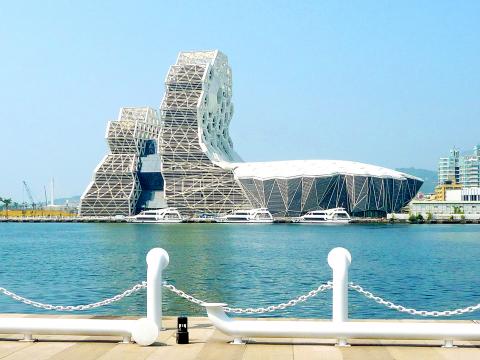
Photo: Steven Crook
Some modern container vessels have drafts of 16m, double the water depth at the old berths in Gushan (鼓山), Yancheng (鹽埕) and Lingya (苓雅) districts. To handle these huge ships, intercontinental container terminals have been constructed in the districts of Cianjhen (前鎮) and Siaogang (小港).
As the harbor’s center of gravity shifted southeast-ward, an enticing amount of land became available. I’ve been reading about the “Asia New Bay Area” (亞洲新灣區), Kaohsiung City Government’s ambitious plan to redevelop this stretch of waterfront, for years. But before last week, I’d never taken a close look at the new landmarks. Some of them are complete, others are still taking shape.
I considered hiring a bicycle from a rental business beside Sizihwan Metro Station (西子灣站). In the end I opted to walk, first to Gushan Ferry Dock (鼓山輪渡), then east along the waterfront toward Kaohsiung Exhibition Center (高雄展覽館).
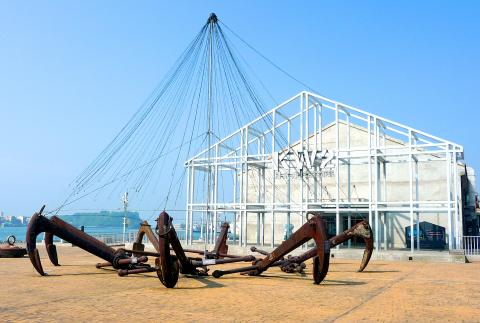
Photo: Steven Crook
Gushan Ferry Dock is where tourists board the boat to Cijin Island (旗津島). Wanting to stay on the “mainland,” I worked my way through a densely packed and impoverished-looking neighborhood to Gushan Fishing Port (鼓山魚港). I didn’t see anything there I haven’t seen before at bigger and livelier fishing ports, so my camera stayed in my bag.
Skirting the small naval base, I spotted a ship I’ve seen before but never traveled on. The Tai Hua (台華輪) is a roll-on/roll-off ferry which connects Kaohsiung with Magong (馬公) in Penghu County. It’s now 30 years old and could do with a fresh lick of paint.
A quartet of government buildings stands just back from the water’s edge on Jiesing 1st Street (捷興一街), and behind them there are remnants of the railway line which used to link the dockside to the rest of Taiwan’s rail network. The official building I’m most curious about is the Kaohsiung-Pingtung Regional Center of the Ministry of Health and Welfare’s Centers for Disease Control, (疾病管制署高屏區管制中心高雄港辦事處). It wouldn’t surprise me if the staff have some good stories about scrambling into action when ships from distant lands arrive carrying sick crewmen or passengers.
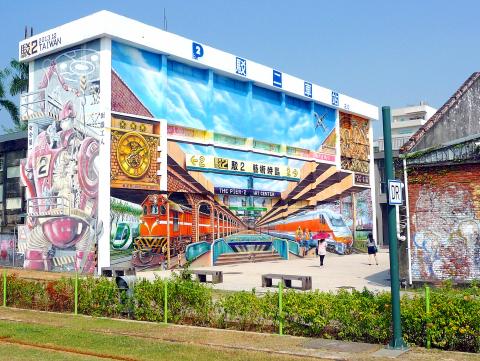
Photo: Steven Crook
Continuing east, I entered KW2 (棧貳庫KW2). Parts of this repurposed warehouse date from 1914. After World War II, concrete was used to replace original brickwork that had been damaged by air raids. From 2017 to last year, it was given a new roof, and internally remodeled in a way that retains a good bit of its old character while adding user-friendly features like modern bathrooms. The elevator — all new public facilities in Taiwan are required to ensure barrier-free access for the disabled — is tastefully encased in salvaged iron sheets.
Every corner of KW2 is occupied by a shop or an F&B business. As a tourist attraction, it’s far superior to the adjacent Banana Pier (香蕉碼頭海景宴會館), which for some time has focused on hosting weddings and other banquet events.
I tramped past Kaohsiung Harbor Museum (高雄港港史館) at 3 Penglai Road (蓬萊路). The museum occupies a colonial-period two-floor building but is currently closed. No announcements have been made regarding renovation or reopening.
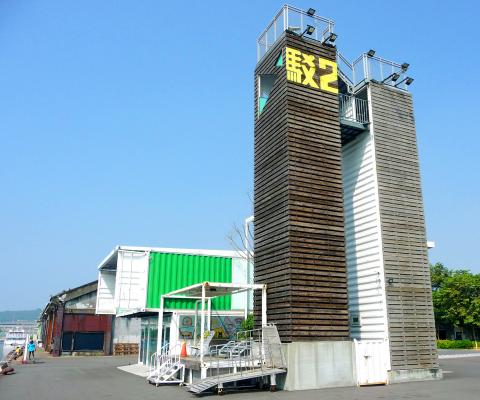
Photo: Steven Crook
Land reclamation during Japanese rule created a peninsula of land here where cruise ships now tie up; there were two on the day of my walkabout. The authorities have much improved the landscape here by adding a long stretch of garden with small trees and its own waterway. There are even patches of sand where children can play.
The former warehouses and railway workshops reinvented as Pier-2 Art Center (駁二藝術特區) are famous enough, so I won’t say much about them. Just before Dayi Pier-2 Station (駁二大義站) on the Kaohsiung Light Rail (also known as the Green Line), I stopped to look at an interesting example of “cargotecture,” the stacking and modification of intermodal shipping containers so they can be upcycled into durable buildings.
Pier-2 Tower (駁二塔) consists of a dozen containers, including two placed on their ends. One part is a shop selling cartoon-themed souvenirs. Another is an observatory which was closed when I passed by on a midweek morning. It may not seem much for NT$7 million, but unlike a conventional building it can be reassembled elsewhere if the land is needed.
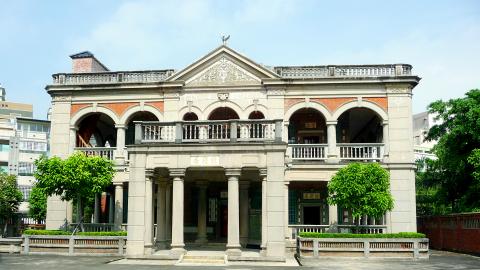
Photo: Steven Crook
A key element of the Asia New Bay Area, Kaohsiung Maritime Cultural & Pop Music Center (高雄海洋文化及流行音樂中心), is under construction on both sides of the mouth of Love River (愛河). To the west there’s the boot-shaped multi-story main concert hall, which will seat 5,000 people indoors and up to 12,000 people outside.
The main structure on the eastern side — which I reached by using the old railway bridge, now a pedestrian/bicycle crossing point — has a roof which looks like it was inspired by bubble wrap. But when I followed the Light Rail along Haibian Road (海邊路), I came to a set of six new buildings far more pleasing to the eye. It isn’t obvious from street level, but each is hexagonal and no two are precisely the same. These are small-scale venues, and not just for music. Last year, they hosted a 37-nation e-sports event.
Having had enough modernity, I headed away from the water to see a relic from when Kaohsiung first boomed. Chen Jhong-he Memorial Hall (陳中和紀念館) honors business magnate Chen Chung-ho (陳中和, 1853-1930), who made his fortune selling sugar to Japan, and importing cloth and petroleum to Taiwan. He had this two-floor mansion built in 1920, and externally it remains in fairly good condition. If you want to see inside, your only chance is on the second Saturday of each month, between 10am and 4:30pm. Admission is free.
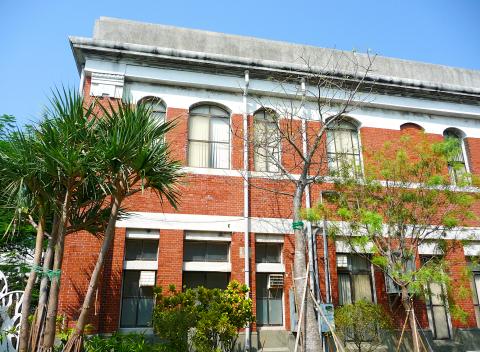
Photo: Steven Crook
Steven Crook has been writing about travel, culture, and business in Taiwan since 1996. He is the co-author of A Culinary History of Taipei: Beyond Pork and Ponlai, and author of Taiwan: The Bradt Travel Guide, the third edition of which has just been published.

The People’s Republic of China (PRC) last week offered us a glimpse of the violence it plans against Taiwan, with two days of blockade drills conducted around the nation and live-fire exercises not far away in the East China Sea. The PRC said it had practiced hitting “simulated targets of key ports and energy facilities.” Taiwan confirmed on Thursday that PRC Coast Guard ships were directed by the its Eastern Theater Command, meaning that they are assumed to be military assets in a confrontation. Because of this, the number of assets available to the PRC navy is far, far bigger

The 1990s were a turbulent time for the Chinese Nationalist Party’s (KMT) patronage factions. For a look at how they formed, check out the March 2 “Deep Dives.” In the boom years of the 1980s and 1990s the factions amassed fortunes from corruption, access to the levers of local government and prime access to property. They also moved into industries like construction and the gravel business, devastating river ecosystems while the governments they controlled looked the other way. By this period, the factions had largely carved out geographical feifdoms in the local jurisdictions the national KMT restrained them to. For example,

The remains of this Japanese-era trail designed to protect the camphor industry make for a scenic day-hike, a fascinating overnight hike or a challenging multi-day adventure Maolin District (茂林) in Kaohsiung is well known for beautiful roadside scenery, waterfalls, the annual butterfly migration and indigenous culture. A lesser known but worthwhile destination here lies along the very top of the valley: the Liugui Security Path (六龜警備道). This relic of the Japanese era once isolated the Maolin valley from the outside world but now serves to draw tourists in. The path originally ran for about 50km, but not all of this trail is still easily walkable. The nicest section for a simple day hike is the heavily trafficked southern section above Maolin and Wanshan (萬山) villages. Remains of

With over 100 works on display, this is Louise Bourgeois’ first solo show in Taiwan. Visitors are invited to traverse her world of love and hate, vengeance and acceptance, trauma and reconciliation. Dominating the entrance, the nine-foot-tall Crouching Spider (2003) greets visitors. The creature looms behind the glass facade, symbolic protector and gatekeeper to the intimate journey ahead. Bourgeois, best known for her giant spider sculptures, is one of the most influential artist of the twentieth century. Blending vulnerability and defiance through themes of sexuality, trauma and identity, her work reshaped the landscape of contemporary art with fearless honesty. “People are influenced by